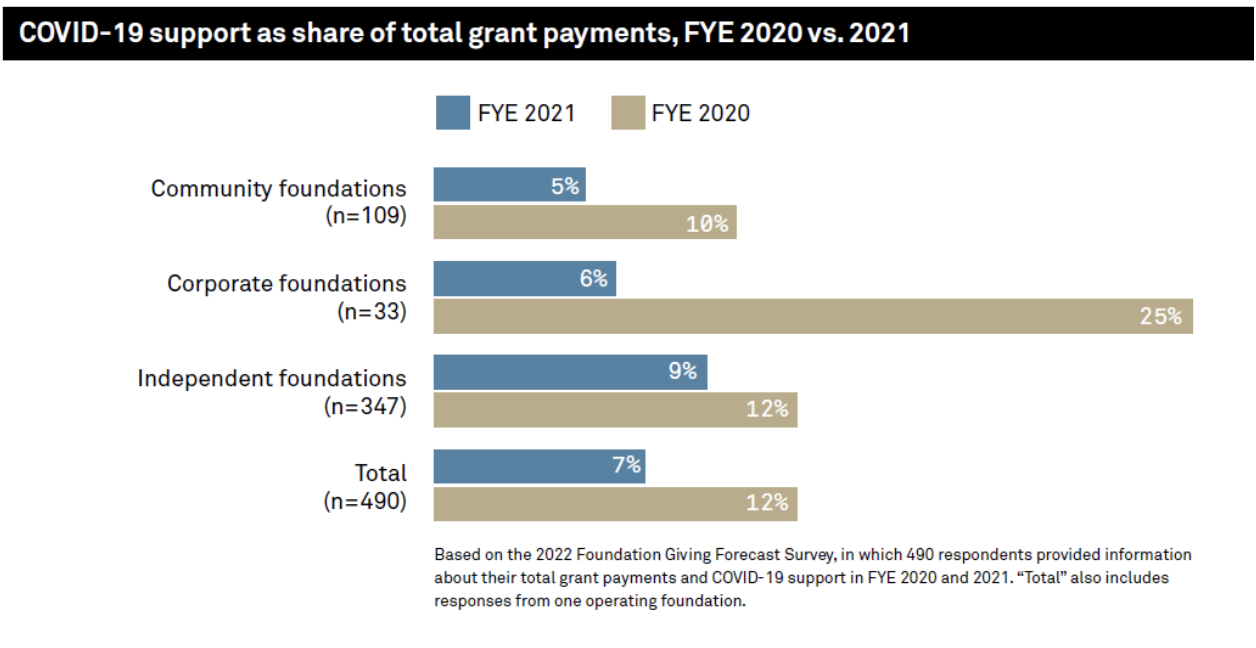New Report Finds At Least $1B Given by Wealthy Donors, Corporations, and Foundations for COVID-19 in 2021
Candid and the Center for Disaster Philanthropy note a drop in giving by large U.S. foundations from 2020, urge donors to increase support for long-term community recovery from the pandemic
New York, NY, and Washington, DC—May 25, 2022 — Candid and the Center for Disaster Philanthropy (CDP) released a new report, Philanthropy and COVID-19: Examining two years of giving, that details COVID-19-related philanthropic funding in 2021. Candid and CDP’s third assessment of COVID-19 philanthropic data notes a concerning decline in giving by large U.S. foundations even as communities face decades-long efforts to recover from the compounding effects of the pandemic. The new report highlights the need for more philanthropic support for long-term recovery, and CDP provides actionable steps funders can take to invigorate their COVID-19 giving strategy, including:
- Increase support to marginalized communities.
- Provide flexible funding to grantees.
- Implement trust-based philanthropy.
- Fund as locally and grassroots as possible.
- Commit to transparency by sharing grants data with Candid.
In previous reports, CDP and Candid noted the record amount of disaster-related funding for the pandemic. The new report includes analysis of Candid’s coronavirus data set (as of December 15, 2021) to illuminate funding trends among U.S. foundations, corporations, and high-net-worth individuals. To date, Candid has recorded $1 billion for COVID-19 in 2021. Additional key findings from the report include:
- 18% of COVID-19 funding was explicitly designated as flexible funding or general support.
- 17% of funding was coded for policy, advocacy, and systems change.
- Health, human service, and education organizations received the highest shares of funding.
- U.S. donors allocated 22% of funding dollars to recipients based outside the United States.
- For U.S.-focused domestic funding, 27% of dollars was explicitly designated for racial and ethnic identities. Of this, 71% didn’t indicate a specific identity, but instead, was broadly designated for “racial equity” or “communities of color.”
This report also examines data from Candid’s Foundation Giving Forecast Survey, which surveys large U.S. foundations about their grantmaking. This year’s survey asked respondents about their total grant payments in FYE 2020 and 2021 and also sought to find out how much of this funding was specifically for COVID-19-related support. Results show:
- An 11% increase in overall grantmaking, but a 31% decline specifically for COVID-19-related funding in FYE 2021.
- Corporate foundation funding for COVID-19 decreased by 76%; community foundations’ funding decreased by 43%; and funding by independent foundations decreased by 24%.
- COVID-19 funding accounted for 7% of total giving in FYE 2021, compared to 12% in FYE 2020.
“Overall, surveyed funders did not maintain their COVID-19 support in the second year of the pandemic,” observes Grace Sato, director of research at Candid. “But defining COVID-19 support can be challenging. Since there isn’t a universal definition of COVID-19 funding, survey respondents used their own criteria to estimate how much of their grant payments were allocated for COVID-19. Many may not have considered increased general support or increased flexibility as part of their pandemic funding.”

To illustrate funding flows outside the U.S., country and regional experts described the philanthropic response in their localities. The report presents snapshots of COVID-19 funding in 11 countries, including case studies of how philanthropy responded to the crisis in India, Brazil, and Ukraine.
The report also provides information about CDP’s approach to disaster grantmaking. In 2021, CDP granted nearly $2.6 million in 2021 to address psychosocial health and wellbeing needs after disasters.
“We strongly believe that mental health is an area that will need ongoing funding to support global COVID-19 recovery,” said Regine A. Webster, vice president of CDP. “Our communities—especially communities of color—are going to feel the impacts of the pandemic for decades to come. We need to keep the momentum in ensuring that frontline organizations have the financial resources to address immediate needs and root causes to help all community members thrive.”
Philanthropy and COVID-19: Examining two years of giving is available here.
The Council on Foundations (CoF) will host a discussion on the report’s key findings during a free webinar on Wednesday, June 1 at 2 p.m. EDT/1 p.m. CDT/12 p.m. MDT/11 a.m. PDT. CoF Vice President of Memberships, Development and Finance Natalie Ross will moderate the discussion. Panelists include Grace Sato, Regine Webster, and Tonia Wellons, president and CEO of the Greater Washington Community Foundation. Lori Bertman, president and CEO of the Irene W. and C.B. Pennington Foundation, which funded the report, will provide welcoming remarks.
About Candid
Every year, millions of nonprofits spend trillions of dollars around the world. Candid finds out where that money comes from, where it goes, and why it matters. Through research, collaboration, and training, Candid connects people who want to change the world to the resources they need to do it. Candid’s data tools on nonprofits, foundations, and grants are the most comprehensive in the world. In 2019, Foundation Center and GuideStar joined forces to become Candid, a 501(c)(3) nonprofit organization. Find out more at candid.org and on Twitter @CandidDotOrg.
CDP mobilizes philanthropy to strengthen communities’ ability to withstand disasters and recover equitably when they occur. It provides expert advice and educational resources, supports diverse coalitions and manages domestic and international disaster funds on behalf of corporations, foundations and individuals through targeted, holistic and localized grantmaking. Find out more at disasterphilanthropy.org and on X and LinkedIn.